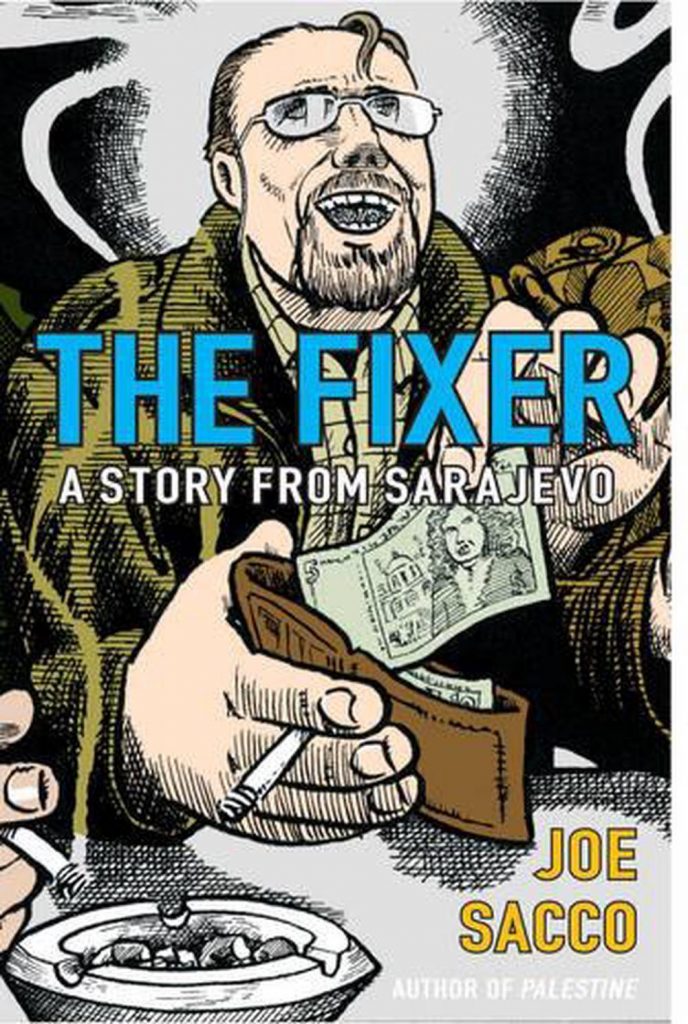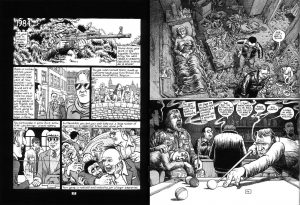Review by Ian Keogh
Joe Sacco’s 1990s trips to Sarajevo resulted in two books. The two stories themselves combined for War’s End were subsequently further matched with this for The Fixer and Other Stories, but it was Safe Area Goražde that made Sacco’s reputation. His sympathetic and horrific depiction of a city under siege and what was once a nation fragmented into different countries and torn to pieces might have turned out very differently were it not for Neven, the Fixer of the title. Sacco meets him in a hotel lobby on his first trip to Sarajevo, and his contacts, knowhow and ingenuity go a long way to enabling Sacco’s subsequent reportage. Sacco acknowledges this over the first pages of a story encompassing Neven’s past and stretching forward to 2001 when Sacco hopes to meet Neven again.
Sacco differentiates Neven’s past from the present of the 1990s via use of black page bordering, and the incidents covered in the sample page alone are a movie in themselves. It’s contracted to the single page because it’s only relevant in establishing the type of man Neven is, and because there’s so much more to come. When the Yugoslavian state collapsed, despite Serb parentage Neven decided he wouldn’t join the Serb nationalists because he didn’t hate anyone. As he lightens Sacco’s wallet meal by meal, he spins forth the dozens of stories stitched together for The Fixer, which has by now surely repaid all those 1990s expenses.
Neven’s experiences are provided as he’s used both as facilitator and historical resource, Sacco careful to phrase some comments as Neven’s rather than fact, as others contradict his stories. Narratively Neven is used as the means of imparting what life was like when Sarajevo was under siege. He knows everyone in Sarajevo, enabling Sacco to provide brief biographies of those who led the Bosnian resistance to the Serbs. Neven himself hardly has a spotless past, yet Sacco details how a place in history for several criminals is cemented by their leading Bosnian resistance groups, and how their methods funded the resistance. It’s a clever piece of journalism, leading readers in one direction then asking them to consider the alternative. Yes, it’s the lesser of two evils for sure, but the gap is broad. Then try telling that to people evicted from their homes with nothing so those homes could be occupied by freedom fighters.
Sacco constructs The Fixer as the rise and fall of the Bosnian warlords, and Neven is both source and representative in microcosm. It’s a murky, horrible presentation of desperate times, political expedience and nest feathering, and although Sacco sometimes shows Neven as a likeable rogue, he doesn’t shy away from unlikeable views and activities. Neven might not hate, but contempt for the refugees flooding into Sarajevo displays an unpleasant side. However, he can see the future of people like himself being necessary during war, yet shunned when peace returns.
There have been plenty of wars since events in Bosnia, with a passing comment about Ukranian peace-keepers in 1990s Sarajevo striking an anomalous note post Russia’s 2022 invasion. The Fixer provides both a window into how grim life is during wartime when everything breaks down and prompts questions concerning how much is acceptable in the defence of a nation. It’s depressing, but powerful, and how many readers would want to leave their armchairs and produce it like Sacco has?






